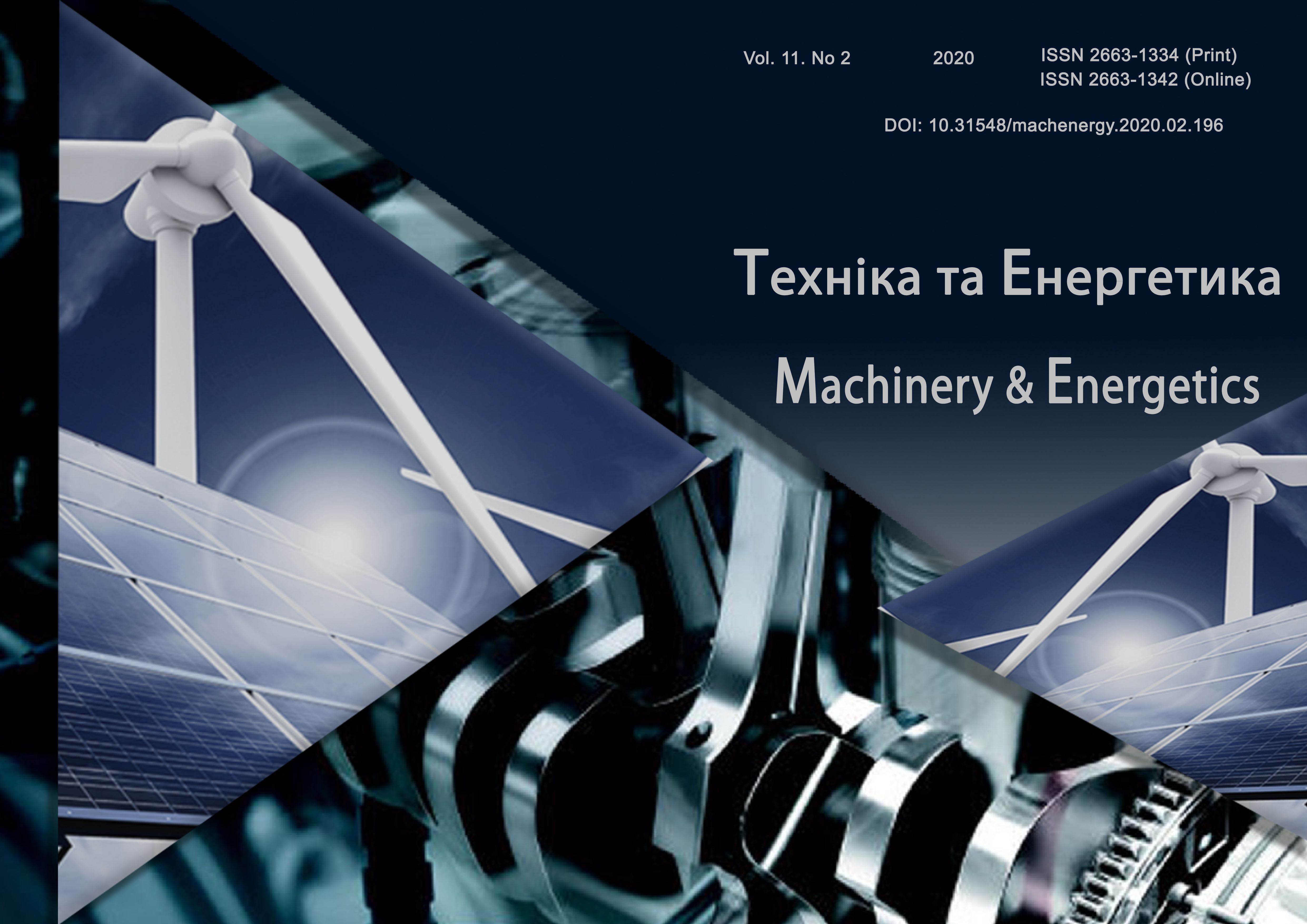Comprehensive optimization of mode of departure of boom system of loader crane
DOI:
https://doi.org/10.31548/machenergy2020.02.005Keywords:
loader crane, optimization, dynamic loads, criterion, load fluctuations.Abstract
The article presents a method for solving the problem, eliminating the oscillations of the load on the knuckle join suspension the simultaneous movement of two elements of the boom system, namely, lifting the jib and movement the telescopic section. The essence of the method is based on the optimization of the regime of simultaneous movement of two elements of the boom system of the loader crane during horizontal movement of the load during the start-up period.
As an optimization criterion, a complex integral criterion was selected, which is a relative root-mean-square value of forces and powers in hydraulic drive cylinders. The developed criterion displays the undesirable properties of the boom system elements and drives mechanism, therefore, its values are minimized.
Since the optimization criterion is an integral functional, variational calculus method are used to optimize it. The solution of the variational optimization problem is presented in the form of many parametric functions that satisfy the boundary conditions of motion and minimize the complex dimensionless criterion. For this purpose, the particle swarm optimization method (ME-PSO) was used. This made it possible to obtain the dependences of the optimal, energy and forces characteristics of the boom system and the drive mechanisms of the crane. The mode of movement of the boom system elements obtained as a result of optimization improved the forces and energy characteristics of the loader crane, which made it possible to increase its reliability and productivity.
References
Loveikin V., Romasevich Y, Spodoba O. (2019). Mathematical model of the dynamics varying the radius jib system loader crane with a load at adjustment movement. Machinery & Energetics. Journal of Production Research Vol. 10. No 1. 141-149. DOI: 10.31548/machenergy.2019.01.141-149.
Mischuk D. (2018). Research dynamics of the boom manipulator mounted on elastic resistance Underwater technologies. Industrial and civil engineering. No 8. 54-56.
https://doi.org/10.26884/uwt1808.1301
Gulianitsky L., Mulessa O. (2016). Applied methods of combinatorial optimization: teach. manual Kiev. Publishing and printing center "Kyiv University". 142.
Kovalsky V.F. (2016). Mathematical modeling of the dynamics of the handling system of a mobile transport-technological machine, taking into account the elasticity of the links. MAMI, №3, 9-15.
Milto A.A. (2016). Dynamic and strength analysis of hydraulic crane-manipulators of mobile transport-technological machines (Unpublished candidate thesis). Moscow.
Bakai B.Ya. (2011). The previous presentation of the dynamic of the manipulator by the Lagrange-Euler method. Vidavnitstvo NLTU Ukraine, 322-327. Lviv.
Bozorg-Haddad O., Solgi M., Loáiciga H. (2017). Meta‐Heuristic and Evolutionary Algorithms for Engineering Optimization. Hoboke, USA, John Wiley & Sons Inc, 304.
https://doi.org/10.1002/9781119387053
Pylypaka, S.F., Nesvidomin, V.M., Klendii, M.B., Rogovskii, I.L., Kresan, T.A., Trokhaniak, V.I. (2019). Conveyance of a particle by a vertical screw, which is limited by a coaxial fixed cylinder. Bulletin of the Karaganda University - Mathematics. Vol. 95. Issue 3. 108-118. WoS. https://doi.org/10.31489/2019M2/108-119
Dubrovka F., Vasilenko D. (2009). Constructive synthesis of planar antennas using natural optimization algorithms. Izvestiya high schools, Radio electronics. No. 4. 3-22.
https://doi.org/10.3103/S0735272709040013
Kiranyaz S., Ince T., Yildirim A., Gabbouj M. (2009). Evolutionary Artificial Neural Networks by Multi-Dimensional Particle Swarm Optimization. Neural Networks. Vol. 22. Issue 10. 1448-1462. https://doi.org/10.1016/j.neunet.2009.05.013
Heo J., Lee K., Garduno-Ramirez R. (2006). Multiobjective Control of Power Plants Using Particle Swarm Optimization Techniques. IEEE Transactions on Energy Conversion. Vol. 21. Issue 10. 552-561. https://doi.org/10.1109/TEC.2005.858078
Zamani M., Karimi-Ghartemani M., Sadati N., Parniani M. (2009). Design of a Fractional Order PID Controller for an AVR Using Particle Swarm Optimization. Control Engineering Practice. Vol. 17. 1380-1387. https://doi.org/10.1016/j.conengprac.2009.07.005
Chander A., Chatterjee A., Siarry P. (2011). A New Social and Momentum Component Adaptive PSO Algorithm for Image Segmentation. Expert Systems with Applications. Vol. 38. Issue 5. 4998-5004. https://doi.org/10.1016/j.eswa.2010.09.151
Romasevych Y., Loveikin V. (2018). A Novel Multi-Epoch Particle Swarm Optimization Technique. Cybernetics and Information Technologies, Bulgarian Academy of Science. Vol. 18(3). 62-74. https://doi.org/10.2478/cait-2018-0039
Loveikin V., Romasevych Y., Kadykalo I., Liashko A. (2019). Optimization of the swinging mode of the boom crane upon a complex integral criterion. Journal of Theoretical and Applied Mechanics. Vol. 49. Issue 3. 285-296. Scopus.
https://doi.org/10.7546/JTAM.49.19.03.07
Loveikin V., Romasevich Y., Khoroshun A., Shevchuk A. (2018). Time-Optimal Control of a Simple Pendulum with a Movable Pivot. Part 1. International Applied Mechanics. Vol. 54(3). 358-365.
Downloads
Published
Issue
Section
License
Relationship between right holders and users shall be governed by the terms of the license Creative Commons Attribution – non-commercial – Distribution On Same Conditions 4.0 international (CC BY-NC-SA 4.0):https://creativecommons.org/licenses/by-nc-sa/4.0/deed.uk
Authors who publish with this journal agree to the following terms:
- Authors retain copyright and grant the journal right of first publication with the work simultaneously licensed under a Creative Commons Attribution License that allows others to share the work with an acknowledgement of the work's authorship and initial publication in this journal.
- Authors are able to enter into separate, additional contractual arrangements for the non-exclusive distribution of the journal's published version of the work (e.g., post it to an institutional repository or publish it in a book), with an acknowledgement of its initial publication in this journal.
- Authors are permitted and encouraged to post their work online (e.g., in institutional repositories or on their website) prior to and during the submission process, as it can lead to productive exchanges, as well as earlier and greater citation of published work (See The Effect of Open Access).

